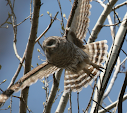
The Eldorado Mountain Open Space is located in southern Boulder County, and encompasses the range of environments that are covered by the generalization, Front Range. Each time I am up there I find my self wondering just how I spent the better part of fifteen years in the area, and am just now beginning to make my visits there a priority. As I have documented in many previous posts the area is one that really resonates with something deep inside me, from the grassy hills around Doudy Draw and Marshall Mesa, to the jagged ridgeline of the hogbacks, and the steep meadows hidden behind outcroppings where deer and elk can be seen grazing from across a canyon.
This particular area has a mining history that is at times hidden away and waiting to be discovered beneath the forest canopy, and at others is plainly obvious to anyone in the area. To access the Goshawk Ridge loop trail on Monday I climbed the initial rise, and then turned right, to head north along the ridge to a road cut. I walked slowly admiring the sharp angles of the steep cut walls. A functionality first road, made in a bygone era - here evidence of the blasting holes wasn't worth the bother of cleaning up. I wasn't alone as the history soaked in. The furry guy below accompanied me through the cut, chatting all the while.
The road swung back to the south as it ran back along the western side of the ridge. On the downhill side a micro-environment of lush vegetation and on my left a much drier rocky slope with some evidence of the fire that had charred the eastern side of the ridge. This was the area where I had located the Black-headed Grosbeaks. In addition I found what I believe to have been some form of apple, growing from below up to the roadside. It was so much bushier than the apple tree from my childhood backyard that I had to take another look. As autumn nears I'll have to check back on that.
On the uphill side I had this butterfly pause. In the field I thought Mourning Cloak, but I now see that it is something different. One more item to put on the lookup list.

In the previous post about this hike I mentioned that at the point where the loop trail crosses over the ridge and begins it descent through the ponderosas that I had stopped to observe a lone mule deer as it munched on some grasses. The wind was in my face, so despite this pause to look at me the deer was content to continue snacking. It was only when the turkeys went past that the deer decided to move on.

Those giant ears are a good indication that this is a muley, but the best indicator for all ages and genders is the tail. On a Mule Deer the tail is narrow with a black tip. It looks a bit like a rope that has just barely been dipped in black paint. On a White-tailed Deer the outside of the tail is black with a white fringe, it shows white when the tail is raised to vertical as this more shy species senses trouble.
The coolest way to tell these species apart is when a mature buck is visible. Look at the rack of antlers, on a White-tail there will be a single forward curved prong with smaller individual prongs growing up and back. Mule Deer have antlers that bifurcate, or split, for each new prong. If you see antlers that split, and then split again you are looking at a Mule deer. This works well if you find yourself in a cabin, lodge, or ski chalet and want to impress your friends while warming the belly, or your feet by a fire.
There were several poppy patches in the meadows, and more individual flowers scattered around the area. The poppies completely dominate the other wildflowers in the area with their large blooms and blaze orange color.
As I approached the car Monday evening my pattern of seeing interesting mammal activity continued. This time it was a fox that crossed the road just below the parking area. He was toting something and being mobbed by two angry magpies. While the pictures I got were two blurry to post I believe he had caught a juvenile. The fact that the fox's load didn't seem to have much life left was lost on the magpies, and did nothing to reduce their rage. One of the more sobering views of the natural world around us, but one that make me appreciate a place like Eldorado Mountain Open Space all the more.




Have you ever considered selling or displaying your photography? You have some fantastic shots.
ReplyDelete